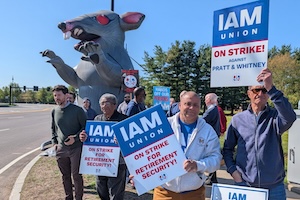
Since May 5, more than 3,000 members of the International Association of Machinists have been on strike at Pratt & Whitney, which produces jet engines for F-35 fighter jets and commercial aircraft including the Airbus A320. Workers, who are picketing the company’s two plants in East Hartford and Middletown, Connecticut are seeking a contract with higher wages, better job security and retirement benefits.
When Between The Lines’ Melinda Tuhus dropped off donated food to picketers on May 11th, she spoke with Phil Clarkin, the picket co-captain for the day, about the strike.
PHIL CLARKIN: We rejected the contract last Sunday, so then we went out on strike as of midnight. They have to come back to us to go to the table with their next best offer. We can keep rejecting all of them as long as we’re able to stay out here. If you come down, say 5:30 to 8 on a Monday through Friday or Saturday, starting next week, so you’ll have all the salary people coming in and all the yellow badges are trying to get in to do our work. So it’ll be loud, it’ll be rowdy, hopefully get Pratt to go back to the negotiating table and get us back inside.
MELINDA TUHUS: Have you gotten much support from people who aren’t in the union who’ve come out?
PHIL CLARKIN: Yep.
MELINDA TUHUS: Is that something you’d like to see?
Tuhus also spoke with John Harrity, former president of the Connecticut State Council of Machinists, and a founding member and chair of the Connecticut Roundtable on Climate and Jobs, a group which seeks to unite the fight to address the climate crisis with more standard labor demands. Here, Harrity recounts how he helped overcome initial opposition to a resolution he proposed at the International Association of Machinists National Convention in 2016, that declared that the union would make climate change a priority issue going forward.
JOHN HARRITY: I remember in 2016, I was a delegate to the IAM National Convention, a convention that occurs once every four years. And I presented a resolution for consideration by the convention that said that the IAM would declare that climate change was a priority issue from that point going forward. And that was really all the resolution said when you boil it down.
But the executive council of the Machinist Union opposed a resolution. The resolution committee wanted to report out to the convention that their recommendation was for non-concurrence on the resolution. That is, that people should vote against the resolution. I met with the resolutions committee a couple of different times. I tried to change the wording to address their concerns, but never got their approval.
And then it went to the convention itself because all the resolutions are called up for a membership vote, a delegate vote. So there were people at every mic waiting to talk and all of them said that they were opposed to the resolution.
And then finally, the president of the union — and this is nationally — he said, “Is there anyone to speak in favor?” So I spoke and I told them why I thought it was important and I told them it was a historic moment where we could either get in the lead on this and that people actually are really concerned about it.
I’ve found the main reason people don’t want to talk about it is they think that we’re just really screwed and there’s nothing that can be done. And that’s changed over the years as labor has gotten more deeply involved in this. So that was some of the opposition.
But over time, people have realized that, in fact, that labor needed to weigh in on this, that there were plans being made about their jobs and the future of work that if we were not there, we were still being discussed. All of that is to say that I think that the opposition is fading somewhat and I’m glad of it.
See more articles and opinion pieces in the related links section of this page. For weekly updates on the Trump authoritarian playbook now underway, subscribe here to our Between The Lines Radio Newsmagazine Substack newsletter to get updates to our “Hey AmeriKKKa, It’s Not Normal” compilation.
For the best listening experience and to never miss an episode, subscribe to Between The Lines on your favorite podcast app or platform.
Or subscribe to our Between The Lines and Counterpoint Weekly Summary.




